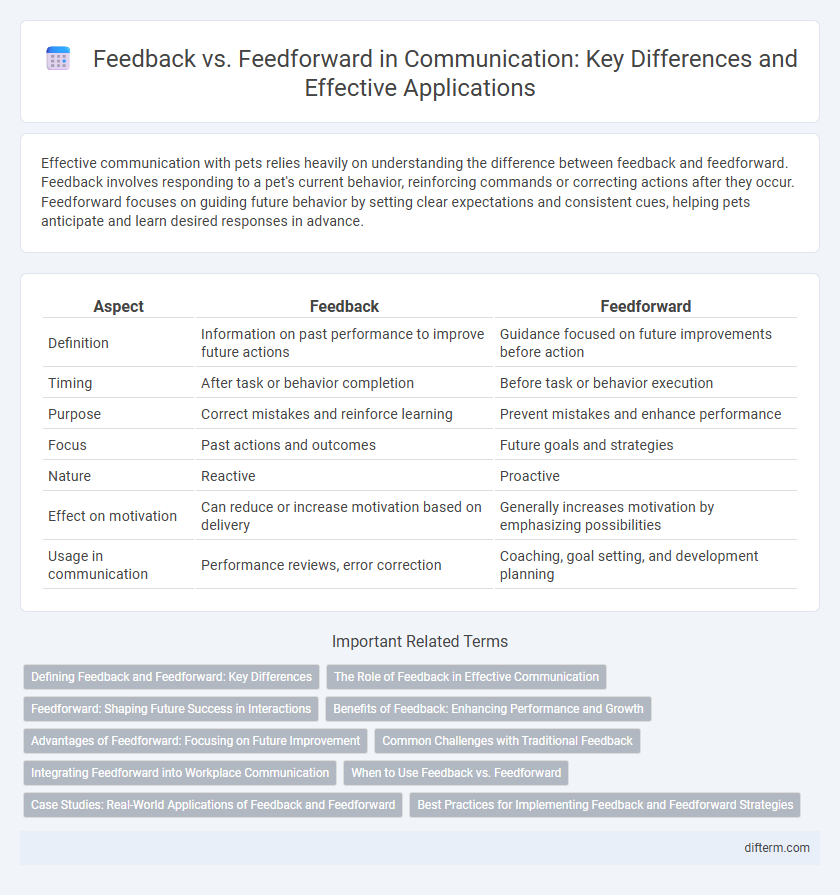Effective communication with pets relies heavily on understanding the difference between feedback and feedforward. Feedback involves responding to a pet's current behavior, reinforcing commands or correcting actions after they occur. Feedforward focuses on guiding future behavior by setting clear expectations and consistent cues, helping pets anticipate and learn desired responses in advance.
Table of Comparison
| Aspect | Feedback | Feedforward |
|---|---|---|
| Definition | Information on past performance to improve future actions | Guidance focused on future improvements before action |
| Timing | After task or behavior completion | Before task or behavior execution |
| Purpose | Correct mistakes and reinforce learning | Prevent mistakes and enhance performance |
| Focus | Past actions and outcomes | Future goals and strategies |
| Nature | Reactive | Proactive |
| Effect on motivation | Can reduce or increase motivation based on delivery | Generally increases motivation by emphasizing possibilities |
| Usage in communication | Performance reviews, error correction | Coaching, goal setting, and development planning |
Defining Feedback and Feedforward: Key Differences
Feedback involves reviewing past actions to provide insights for improvement, focusing on what has already occurred. Feedforward emphasizes future-oriented guidance, offering suggestions and expectations before actions take place. Understanding these distinctions enhances effective communication by balancing reflection with proactive planning.
The Role of Feedback in Effective Communication
Feedback plays a crucial role in effective communication by providing clear, specific, and timely information about how a message is received and interpreted, enabling continuous improvement. It fosters mutual understanding, reduces miscommunication, and enhances interpersonal relationships by allowing adjustments that align with the receiver's needs and expectations. Integrating regular feedback loops promotes transparency, trust, and active engagement, essential for successful collaboration and conflict resolution.
Feedforward: Shaping Future Success in Interactions
Feedforward focuses on shaping future success by offering constructive suggestions that guide individuals toward improved performance and positive outcomes in upcoming interactions. Unlike feedback, which centers on past behavior, feedforward encourages proactive development and fosters a growth mindset essential for effective communication and collaboration. Implementing feedforward techniques enhances relationship-building and drives continuous improvement in personal and professional environments.
Benefits of Feedback: Enhancing Performance and Growth
Feedback provides individuals with specific insights into their current performance, enabling targeted improvements and skill development. It fosters self-awareness by highlighting strengths and areas for growth, which accelerates learning and professional development. Regular constructive feedback cultivates a growth mindset, motivating continuous improvement and increased productivity within teams.
Advantages of Feedforward: Focusing on Future Improvement
Feedforward emphasizes future improvement by providing guidance and suggestions before actions are taken, enhancing proactive behavior and reducing defensiveness often triggered by feedback. This approach fosters a growth mindset, motivating individuals to focus on opportunities and solutions rather than past mistakes. Organizations using feedforward report increased engagement, clearer goal-setting, and more effective communication aligned with continuous development.
Common Challenges with Traditional Feedback
Traditional feedback often faces challenges such as delayed delivery, which reduces its effectiveness by limiting real-time improvement opportunities. It tends to focus on past mistakes rather than future actions, causing defensiveness and resistance in recipients. This reactive nature hampers continuous learning and growth within communication processes.
Integrating Feedforward into Workplace Communication
Integrating feedforward into workplace communication enhances team performance by emphasizing future-oriented suggestions rather than past mistakes, fostering a proactive and growth-focused environment. Unlike feedback, which evaluates previous actions, feedforward encourages employees to consider potential improvements and innovative solutions, boosting motivation and engagement. Incorporating feedforward regularly can transform communication dynamics, resulting in clearer goals, increased collaboration, and continuous professional development.
When to Use Feedback vs. Feedforward
Feedback is most effective after an event or behavior has occurred, allowing individuals to reflect on specific past actions and improve future performance. Feedforward focuses on future-oriented guidance, providing suggestions and strategies before a task or situation takes place to enhance outcomes. Use feedback to address and correct previous results, while feedforward encourages proactive adjustments and growth ahead of time.
Case Studies: Real-World Applications of Feedback and Feedforward
Case studies in communication reveal feedback as a critical tool for assessing past interactions and improving performance in real-time, often seen in customer service and managerial reviews. Feedforward, in contrast, is prominently applied in training and development contexts, where future-oriented guidance helps individuals anticipate challenges and refine skills before execution. Organizations leveraging both feedback and feedforward report enhanced communication effectiveness, increased employee engagement, and accelerated learning outcomes.
Best Practices for Implementing Feedback and Feedforward Strategies
Effective communication hinges on integrating both feedback and feedforward strategies to enhance performance and foster growth. Best practices include setting clear objectives, maintaining specificity, and ensuring timely delivery while cultivating a supportive environment that encourages open dialogue. Leveraging feedforward techniques emphasizes future improvements, whereas feedback focuses on past actions, together creating a balanced framework for continuous development.
feedback vs feedforward Infographic

 difterm.com
difterm.com